LeadGuitarWorkshop.ws Page 6
Lynyrd Skynyrd rocking out at the Big State Festival in College Station, Texas, October 13, 2007.
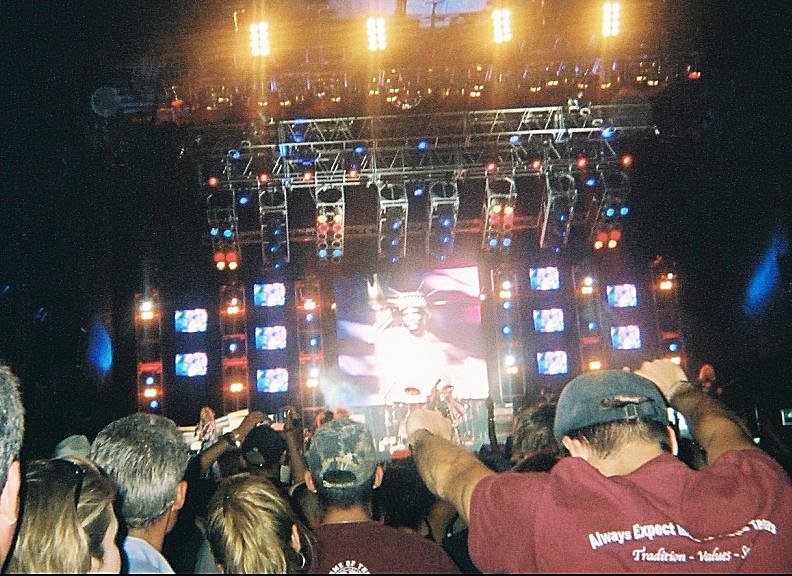
On this page: the Chromatic Scale, Musical Intervals, Chord Formulas, String Bending, Vibrato, the Blues Scale, the Diminished Scale, the Augmented Scale, the Harmonic Minor Scale, & the Gypsy Scale.
The Chromatic Scale
The Chromatic Scale is simply all of the notes from Root to Octave. Including the Root, there are 12 different notes; the 13th note is the Octave, and the scale starts over. In the following graphic, the green notes are the Root notes:
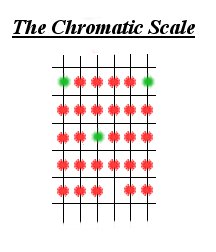
In Music Theory, each note (degree) and interval of the first two Octaves have been given a name as shown in the chart below. On the guitar, adjacent frets are a half-step apart. A musical interval is the distance between two notes; in this chart, the first note is understood to always be the Root note:
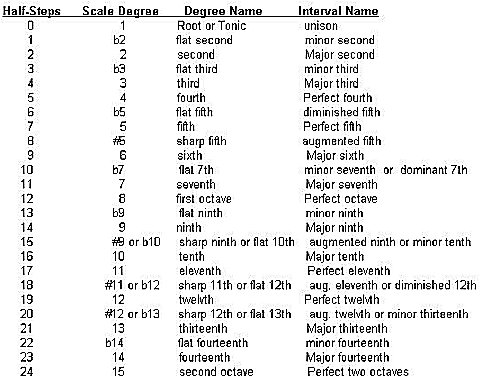
These degree and interval names are used in guitar Chords and Arpeggio formulas, for instance:
Major Chord or Arpeggio = Root, 3, 5
minor Chord or Arpeggio = Root, b3, 5
Augmented Chord or Arpeggio = Root, 3, #5
diminished Chord or Arpeggio = Root, b3, b5
Major 7th Chord or Arpeggio = Root, 3, 5, 7
minor 7th Chord or Arpeggio = Root, b3, 5, b7
dominant 7th Chord or Arpeggio = Root, 3, 5, b7
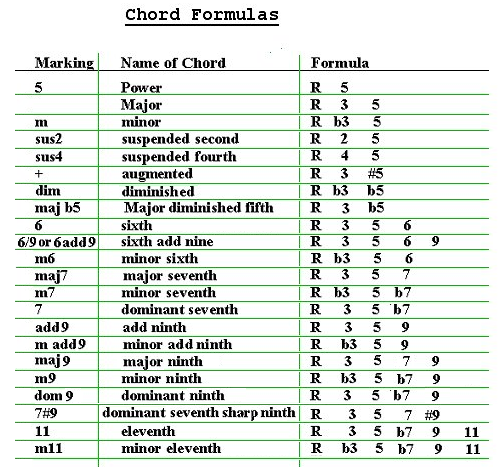
Some things to note:
the inclusion of a flat-3 makes a chord minor
the inclusion of a natural-3 makes a chord Major
the inclusion of a flat-5 makes a chord diminished
the inclusion of a sharp-5 makes a chord augmented
2 instead of 3 makes a chord a suspended 2d
4 instead of 3 makes a chord a suspended 4th
String-Bending & Vibrato
String-Bending, as the name implies, is where you bend a string so that the original note is bent up to some higher tone. Generally speaking, if you bend a note up, you should bend it up to another note in the scale that you are playing, not just bend the note up to some random stopping point. The Blues style is a bit of an exception to this general rule; in the Blues style you will occasionally hear partial or fractional bends for coloration; the point here is to be in control of what you are doing - if you do a partial bend, do it on purpose; if you bend up to a specific note, do that on purpose.
A common String-Bending technique is to use the index, middle, & ring fingers together to bend a string up while at the same time holding a note with your pinky finger on the next adjacent higher string - so you play two notes at once, the pinky note stays fixed while the other note is getting bent up using three fingers. Using three fingers together like this to bend the string up gives you lots of power & control over the bend and just plain feels good.
Another cool String-Bending technique is to bend a note up and then finger-tap other notes higher up on the same string.
Closely related to String-Bending is Vibrato. To add Vibrato, you hit a note and then rhythmically and steadily wiggle the string back-and-forth thereby steadily modulating the pitch of the original note. You can produce different sorts of Vibrato by changing the speed and distance that you wiggle the string.
Guitar Lesson #14 - The Blues
The Blues sound is created by playing a Pentatonic scale and then sprinkling in "chromatic" notes to give it that bluesy sound; the Pentatonic skeleton is emphasized while the "chromatic" notes are tossed in occasionally for coloration. Basically, any note is fair game in The Blues style, but you must always return to the underlying Pentatonic Scale for the solo to sound in Key. To add expression to the lead, The Blues style tends to use lots of string-bending, vibrato, sliding, and Double-Stops. Also, you will notice that often a Blues lead will mimic the human voice, the guitar literally sings; BB King often sings along in unison while he is playing, his voice and the guitar hitting the same notes at the same time. In this next graphic, the black notes form the Pentatonic skeleton while the red notes are the "chromatic" notes:

Blues audio example:
The Augmented Scale
Also called the Whole-Tone scale. Occurs at the 1, 3, & 5 positions of the Harmonic Minor Scale shown further down:
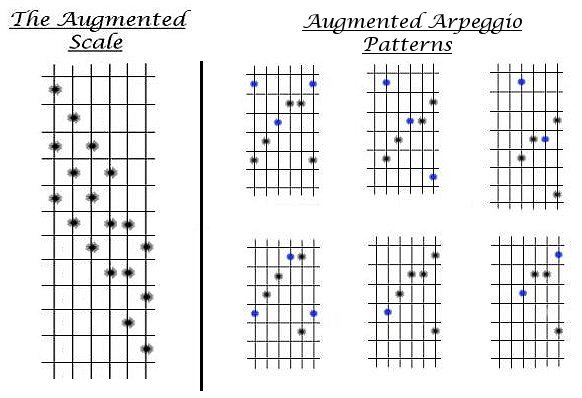
The Diminished Scale
Banned in ancient times for sounding too "devilish," the Diminished scale is a must-know for any modern aspiring guitarist. You will hear it being used extensively in metal bands such as Metallica, Pantera, and Anthrax.You will find that the Pentatonic Scale and the Diminished Scale can be fit together by playing a Pentatonic scale and then using the in-between "Chromatic" notes as the starting point for a Diminished Scale pattern. 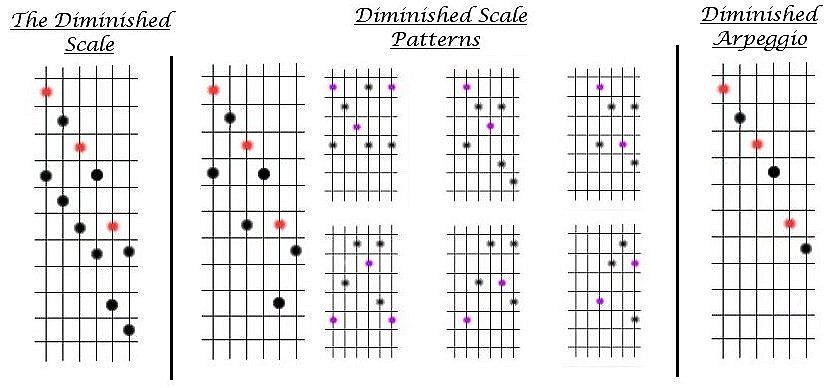
The Harmonic Minor Scale
A favorite scale of Yngwie Malmsteen, the Harmonic Minor Scale has almost the same pattern as the Natural minor (or Aeolian) Scale; if you compare it to the Church Modes Number Pattern, you'll see that all the 5's have been raised 1/2 step (one fret). If you want to play Arpeggios in conjunction with the Harmonic Minor Scale, the type of Arpeggio you do for each tone number (ie, scale degree) will be different than for the Church Modes because of the raised 5th; for the Harmonic Minor: 1=Augmented, 2=minor, 3=Major, 4=Major, 5=diminished, 6=minor, 7=diminished; but rather surprisingly the Augmented & Diminished Scale Patterns shown above also fit right in at the 1's, 3's, & 5's (Augmented) and at the 2's, 4's, 5's & 7's (Diminished), so oddly either a minor arpeggio or a diminished arpeggio will work at the 2 position, either a Major arpeggio or an Augmented arpeggio will work at the 3 position, either a Major arpeggio or a diminished arpeggio will work at the 4 position, & either an Augmented or a diminished arpeggio will work at the 5 position:
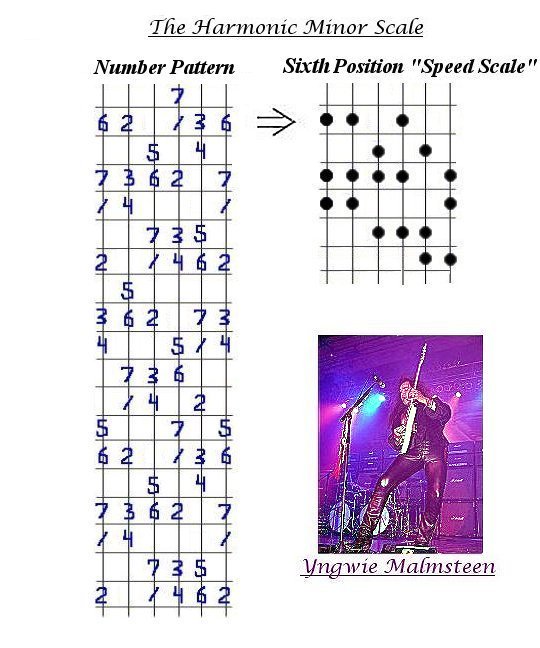
The Gypsy Scale
There are other Exotic Scales that can be found to create a certain feeling. The following Arabic-sounding scale is known as the Gypsy Scale; the 1's are the Root notes: 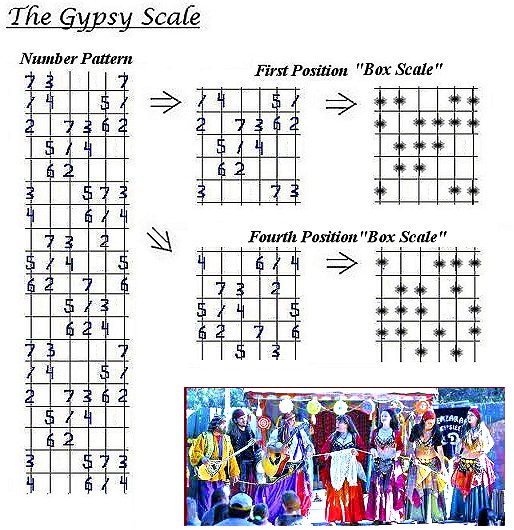
Continued on Page 7.
* * * * * * * * * * * * * * * * * * * * * * * * * * * * * * * * * * * * * * * * * * * * * * * * * * * * * * * * * * * *
Return to Top of this page.
Audio example of moving back and forth between the
Pentatonic Scale and the Diminished Scale: |
|
|